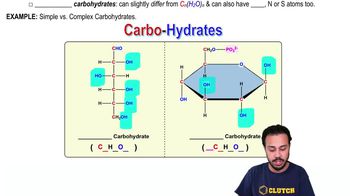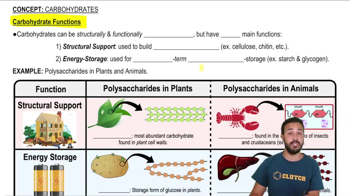Table of contents
- 1. Introduction to Biology2h 40m
- 2. Chemistry3h 40m
- 3. Water1h 26m
- 4. Biomolecules2h 23m
- 5. Cell Components2h 26m
- 6. The Membrane2h 31m
- 7. Energy and Metabolism2h 0m
- 8. Respiration2h 40m
- 9. Photosynthesis2h 49m
- 10. Cell Signaling59m
- 11. Cell Division2h 47m
- 12. Meiosis2h 0m
- 13. Mendelian Genetics4h 41m
- Introduction to Mendel's Experiments7m
- Genotype vs. Phenotype17m
- Punnett Squares13m
- Mendel's Experiments26m
- Mendel's Laws18m
- Monohybrid Crosses16m
- Test Crosses14m
- Dihybrid Crosses20m
- Punnett Square Probability26m
- Incomplete Dominance vs. Codominance20m
- Epistasis7m
- Non-Mendelian Genetics12m
- Pedigrees6m
- Autosomal Inheritance21m
- Sex-Linked Inheritance43m
- X-Inactivation9m
- 14. DNA Synthesis2h 27m
- 15. Gene Expression3h 20m
- 16. Regulation of Expression3h 31m
- Introduction to Regulation of Gene Expression13m
- Prokaryotic Gene Regulation via Operons27m
- The Lac Operon21m
- Glucose's Impact on Lac Operon25m
- The Trp Operon20m
- Review of the Lac Operon & Trp Operon11m
- Introduction to Eukaryotic Gene Regulation9m
- Eukaryotic Chromatin Modifications16m
- Eukaryotic Transcriptional Control22m
- Eukaryotic Post-Transcriptional Regulation28m
- Eukaryotic Post-Translational Regulation13m
- 17. Viruses37m
- 18. Biotechnology2h 58m
- 19. Genomics17m
- 20. Development1h 5m
- 21. Evolution3h 1m
- 22. Evolution of Populations3h 52m
- 23. Speciation1h 37m
- 24. History of Life on Earth2h 6m
- 25. Phylogeny2h 31m
- 26. Prokaryotes4h 59m
- 27. Protists1h 12m
- 28. Plants1h 22m
- 29. Fungi36m
- 30. Overview of Animals34m
- 31. Invertebrates1h 2m
- 32. Vertebrates50m
- 33. Plant Anatomy1h 3m
- 34. Vascular Plant Transport2m
- 35. Soil37m
- 36. Plant Reproduction47m
- 37. Plant Sensation and Response1h 9m
- 38. Animal Form and Function1h 19m
- 39. Digestive System10m
- 40. Circulatory System1h 57m
- 41. Immune System1h 12m
- 42. Osmoregulation and Excretion50m
- 43. Endocrine System4m
- 44. Animal Reproduction2m
- 45. Nervous System55m
- 46. Sensory Systems46m
- 47. Muscle Systems23m
- 48. Ecology3h 11m
- Introduction to Ecology20m
- Biogeography14m
- Earth's Climate Patterns50m
- Introduction to Terrestrial Biomes10m
- Terrestrial Biomes: Near Equator13m
- Terrestrial Biomes: Temperate Regions10m
- Terrestrial Biomes: Northern Regions15m
- Introduction to Aquatic Biomes27m
- Freshwater Aquatic Biomes14m
- Marine Aquatic Biomes13m
- 49. Animal Behavior28m
- 50. Population Ecology3h 41m
- Introduction to Population Ecology28m
- Population Sampling Methods23m
- Life History12m
- Population Demography17m
- Factors Limiting Population Growth14m
- Introduction to Population Growth Models22m
- Linear Population Growth6m
- Exponential Population Growth29m
- Logistic Population Growth32m
- r/K Selection10m
- The Human Population22m
- 51. Community Ecology2h 46m
- Introduction to Community Ecology2m
- Introduction to Community Interactions9m
- Community Interactions: Competition (-/-)38m
- Community Interactions: Exploitation (+/-)23m
- Community Interactions: Mutualism (+/+) & Commensalism (+/0)9m
- Community Structure35m
- Community Dynamics26m
- Geographic Impact on Communities21m
- 52. Ecosystems2h 36m
- 53. Conservation Biology24m
4. Biomolecules
Carbohydrates
Problem 9
Textbook Question
Textbook QuestionGalactosemia is a potentially fatal disease that occurs in humans who lack the enzyme that converts galactose to glucose. If you were a physician treating a person with this disease, which of the following would you have them exclude from their diet? a. maltose b. starch c. mannose d. lactose
 Verified step by step guidance
Verified step by step guidance1
Step 1: Understand the problem. The problem is asking which substance a person with galactosemia should avoid in their diet. Galactosemia is a condition where the body can't convert galactose to glucose due to the lack of a specific enzyme.
Step 2: Recall what each of the substances listed in the options are. Maltose is a sugar made from two glucose molecules, starch is a polysaccharide made from glucose, mannose is a sugar that can be converted to glucose, and lactose is a sugar made from glucose and galactose.
Step 3: Identify the substance that contains galactose. From the options given, only lactose contains galactose.
Step 4: Since people with galactosemia can't convert galactose to glucose, they should avoid substances that contain galactose.
Step 5: Therefore, the answer is lactose.
Recommended similar problem, with video answer:
 Verified Solution
Verified SolutionThis video solution was recommended by our tutors as helpful for the problem above
Video duration:
2mPlay a video:
Was this helpful?
Key Concepts
Here are the essential concepts you must grasp in order to answer the question correctly.
Galactosemia
Galactosemia is a genetic disorder characterized by the body's inability to metabolize galactose, a sugar found in milk and dairy products. This condition arises from a deficiency in the enzyme galactose-1-phosphate uridyltransferase, which is crucial for converting galactose into glucose. Without proper management, galactosemia can lead to serious health complications, including liver damage, cataracts, and intellectual disability.
Enzymatic Function
Enzymes are biological catalysts that facilitate biochemical reactions in the body. In the case of galactosemia, the lack of the enzyme responsible for converting galactose to glucose leads to the accumulation of galactose and its toxic metabolites. Understanding the role of enzymes in metabolic pathways is essential for recognizing how deficiencies can result in metabolic disorders and the dietary restrictions necessary to manage them.
Recommended video:
Guided course

Functional Groups
Dietary Management
Dietary management is a critical aspect of treating metabolic disorders like galactosemia. Patients are advised to avoid foods containing galactose, primarily found in dairy products and certain sugars. In this context, lactose, which is composed of glucose and galactose, must be excluded from the diet to prevent the harmful effects of galactose accumulation, highlighting the importance of dietary choices in managing health conditions.
Recommended video:
Guided course

Ecology

 4:53m
4:53mWatch next
Master Carbohydrates with a bite sized video explanation from Jason Amores Sumpter
Start learningRelated Videos
Related Practice














